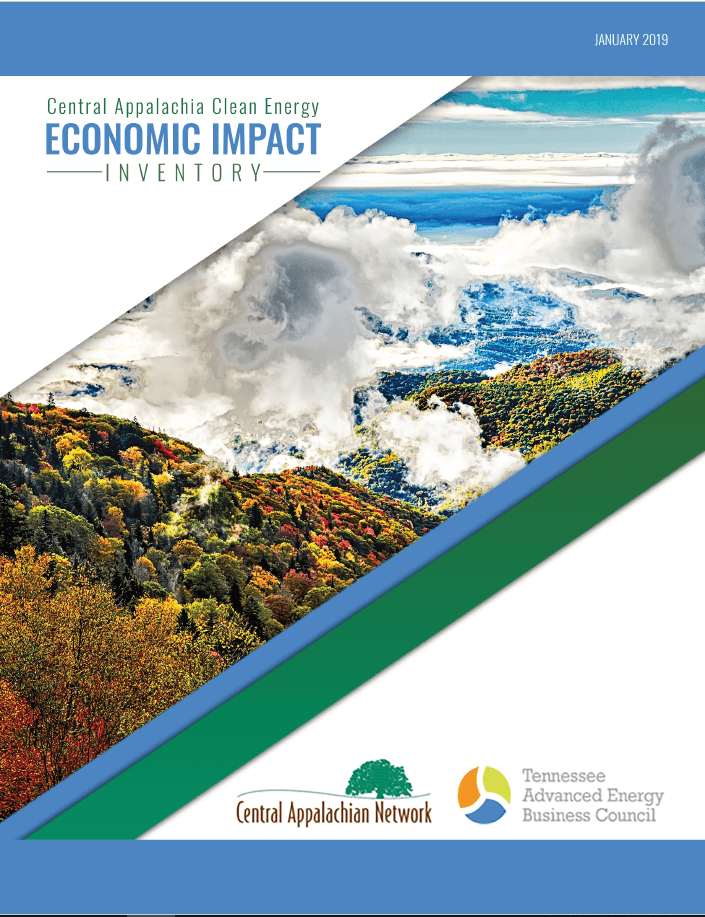
An Inventory of What We Know About Clean Energy and Where Appalachia Goes From Here
By: Emily Arrowwood, Piper Communications & Tennessee Advanced Energy Business Council
What do we know about clean energy’s impact on Appalachia? CAN’s Clean Energy Practitioner group asked this question as the group set about establishing upcoming projects and future goals. A clear, big-picture understanding of clean energy’s current footprint in the region would provide a baseline for CAN to identify strategic opportunities to fill gaps in knowledge and effectively champion clean energy as a transformative investment for Appalachia.
CAN commissioned the Tennessee Advanced Energy Business Council to take stock of clean energy’s economic impact in Appalachia as it is currently known: what data is out there, what data is missing, and most importantly, what data should be out there? On behalf of TAEBC, Piper Communications compiled a directory of economic impact reports from the available universe of studies and databases touching on the Appalachian region. Every effort was made to include relevant, contemporary reports.
The resulting Central Appalachia Clean Energy Economic Impact Inventory is a comprehensive log of economic impact data on clean energy in the region. It features detailed analyses of data gaps and recommendations for CAN to capitalize on identified opportunities.
Click here to download the Central Appalachia Clean Energy Economic Impact Inventory!
HOW TO USE
The Inventory is written as a reference guide to inform clean energy advocates’ initiatives and goals advancing clean energy across Appalachia. Advocates should consult the Inventory and its recommendations when contemplating new projects, to help identify new approaches and best use of resources and avoid duplicating efforts. While useful as a source for checking statistics and specific data points, advocates should be aware that data is ever-evolving due to changing markets, regulations, and resources.
The Inventory catalogues clean energy data in Appalachia by broad topic:
- Clean energy job creation and workforce development data
- Nationwide
- State by state
- Regional
- By specific energy resource
- Energy cost burdens and household savings data
- Energy burdens
- Energy efficiency
- Solar
- By housing type: Single, multifamily, and low-income
- Business development and enrichment opportunities data
- Business development
- Regulatory environment
- Coal
Each topic is broken down into three key chapters:
- Synthesis detailing key takeaways and recommendations arising from existing data and gap analysis
- Outline of existing report data, by topic
- Gap analysis of missing data and desired data
BIG TAKEAWAYS
The Inventory determined that clean energy advocates lack comprehensive, current data on the economic impact of clean energy in Appalachia.
Existing economic impact reports do not follow a consistent definition of “clean” or “renewable” energy; the vast majority focus either on energy efficiency initiatives or specific energy resources, with a nationwide, state, or Census-region viewpoint. Current data on Appalachia itself is largely inaccessible, as the most recent comprehensive economic analysis of renewable energy in Appalachia is more than a decade old.
CAN has the opportunity to capitalize upon this data gap and effect real change by commissioning a regional clean energy economic impact report. Such a report would spotlight the ways in which clean energy is an economic driver in Appalachia. This is vital to pursuing growth of clean energy markets, as concrete evidence of economic benefit would be the single most effective tool for advocates to persuade policymakers, utilities, regulators, business leaders, and the public to support clean energy initiatives and investment. The Inventory explores this opportunity in great detail with key recommendations to maximize impact should CAN or others decide to capitalize on this opportunity.
